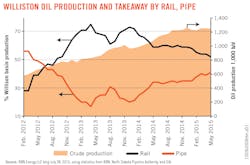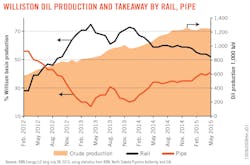Sandy Fielden
RBN Energy LLC, Houston
Bakken crude-by-rail (CBR) volumes are down this year, and pipeline shipments are increasing as production levels off in the wake of last year's price crash. The trend is encouraged by lower price differentials between domestic and international crude as well as new pipelines coming online.
A combination of rail and pipeline has given Bakken producers ample crude takeaway capacity since 2012, but pipelines alone have not had sufficient capacity on their own. However, with production slowing, pipeline capacity is catching up. There should be enough pipelines to carry all North Dakota's crude to market by 2017.
RBN has extensively covered the transportation of Bakken crude out of the prolific Williston basin in North Dakota. Back in 2012, Bakken production quickly outstripped available pipeline capacity-much of which had to be shared with crude from Western Canada.
The result was what we now look back on as a familiar story in the shale era: pipeline congestion and price discounting while producers tried to figure out alternative routes to market. The solution was to build a plethora of CBR load terminals in the Bakken-transforming a famine of pipelines into a feast of rail.
As long as the price differentials between discounted domestic crude stranded in the Midwest and coastal crude priced at higher international prices stayed wide enough, rail was an ideal option for Bakken producers- especially to the East and West Coasts where there is no pipeline capacity.
As soon as price differentials-especially between benchmark West Texas Intermediate and international benchmark Brent-narrowed, then barrels shifted back to pipelines to take advantage of their cheaper tariff rates.
Yet, significant crude volumes continued to be transported to market from North Dakota by rail because pipeline capacity could not handle the demand. More recently, RBN has described the planning and buildout of a series of new pipelines out of North Dakota that (if they are all built) should increase capacity enough to provide space for all the barrels currently travelling to market from North Dakota by rail.
We speculate as to when that day might come and whether it is likely. The balance is changing between percentages of crude being carried out of the Bakken by rail and pipeline since February 2012 (See figure).
The data is from the North Dakota Pipeline Authority (NDPA), which publishes monthly estimates of the balance between crude takeaway modes in percentage terms-based on crude production from the Williston basin as a whole.
We also included the monthly Williston basin production history as a reference using the Energy Information Administration's (EIA) Drilling Productivity Report. There are two big takeaways from this chart. The first is that the amount of crude that needs to be transported out of North Dakota is growing throughout the period-although production growth has leveled off this year in response to falling crude oil prices and lower drilling rates.
The second big takeaway is the change in the relative positions of rail and pipeline takeaway percentages over the period. Pipelines started in the lead back in February 2012 at 56% but fell rapidly to 23% in May 2013 before beginning a gradual recovery in December 2013, and returning to 41% in May 2015 (the latest available data at press time).
Rail started out at 28% in 2012 but zoomed up to 75% by April 2013, falling back to 61% in August 2013 when crude differentials narrowed. It recovered to 73% in December 2013. Since then, rail percentages have been on a steady decline-leveling off some at about 60% in the second half of 2014 but falling again so far this year to 52% in May-their lowest level since October 2012.
This year through May, the trend of increased pipeline and lower rail is quite pronounced as the two lines converge on the chart.
The trend in favor of pipeline transportation out of the Bakken since 2014 primarily has been prompted by the narrowing of price differentials between Brent and WTI: the spread averaged $18/bbl during 2012 reducing to $11/bbl in 2013 and $6.50/bbl in 2014 (averaging $5.94/bbl through July 2015).
These narrower differentials reduce the incentive for CBR, making it harder to justify the higher cost of rail freight to coastal markets. If getting to market by rail does not increase netbacks, and pipeline alternatives are available, then shippers will use them first unless they have a contractual obligation to use rail. The 60% fall in crude prices since June 2014 has amplified rail shipper's cost concerns since they are getting less money from their crude to start with.
Our summary of Bakken transport options shows actual and forecast crude production and transportation capacity out to 2020. RBN calculated "Growth" and "Contraction" scenarios considering crude price forecasts and production statistics.
The Growth scenario envisions a leveling off in 2015 of increases in Bakken crude production to just less than 1.5 million b/d in 2020. Production in the Contraction scenario is forecast to decline to about 1.1 million b/d in 2020.
Production exceeded pipeline capacity in 2012, but that the combination of rail and pipeline capacity has been high enough to cover shipper's needs (assuming it is all online and congestion free).
The pertinent point is when pipeline capacity line crosses crude oil production-sometime in 2017. That is the point where-in theory-all Bakken production could be transported to market by pipeline, potentially leaving North Dakota rail terminals deserted.
New pipeline projects due online at the end of 2016 and during 2017 will expand Bakken takeaway pipeline capacity by 680,000 b/d. These are the 230,000 b/d Enbridge Sandpiper expansion of the North Dakota Pipeline system to Superior, WS in 2017, and the Energy Transfer Partners and Phillips 66 joint venture 450,000 b/d Dakota Access pipeline (DAPL) from North Dakota to Patoka, Ill., planned online by the end of 2016.
Sandpiper primarily will feed into the Enbridge Western Gulf Access pipeline system to Cushing and Houston, although some Bakken barrels could feed Midwest and Eastern Canadian refineries. An extension to DAPL, known as the Energy Transfer Crude Oil Pipeline (ETCOP), will take oil all the way to the Sunoco Nederland terminal on the Texas Gulf Coast and a subsequent pipeline proposal from Phillips 66 would facilitate shipments to St. James, La.
Another 100,000 b/d of pipeline capacity out of the Bakken will come in 2019 if the TransCanada Keystone XL pipeline is completed. Another 220,000 is coming in 2020 if the TransCanada Energy East project is built that includes a planned Upland "on-ramp" pipeline in North Dakota taking 220,000 b/d of Bakken crude into Eastern Canada.
Of course, if North Dakota crude production had continued at the same breakneck pace in 2015-16 as it did during 2013-14, Bakken shippers would still be dependent on rail to get at least some of their barrels to market even with all these pipeline additions.
But lower crude prices and cutbacks in new drilling over the past year have reduced expectations for increased crude production and opened the possibility that pipelines could take the place of rail as early as sometime in 2017. However-and here's the complicated part-just because pipeline capacity is available doesn't necessarily mean producers will prefer to use that capacity instead of rail.
In the long run-assuming that they do not have other overriding obligations-shippers will look to their crude netbacks at the wellhead to decide where and how to send their crude to market. That means they should favor market locations where the combination of crude sales price less transport is the highest-regardless of transport mode.
Editor's note: This is from a July 28 RBN Energy blog, and used with permission from RBN.
The author
Sandy Fielden is RBN Energy director of energy analytics. His daily blogs are read by thousands of energy professionals. Previously, he was Allegro vice-president of data services, and also was vice-president energy products and services at LIM (now Morningstar Commodity Data). Before that, Fielden was product manager at Saladin. He has a broad knowledge of energy markets and readily communicates complex industry topics to different audiences. His analysis of US crude oil markets regularly is quoted by Reuters, Bloomberg, and the Wall Street Journal.


